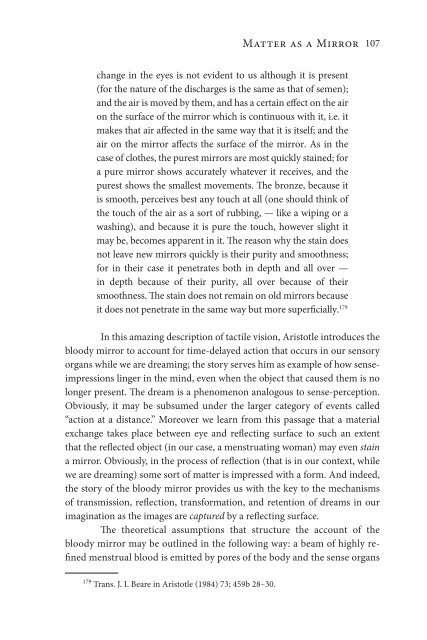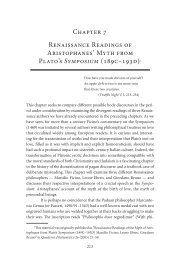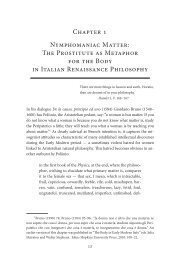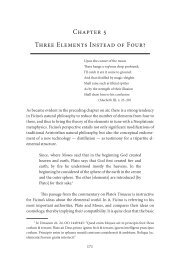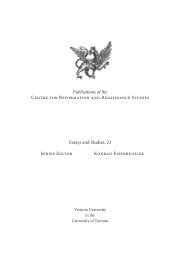Chapter 2 Matter as a Mirror: Marsilio Ficino and Renaissance ...
Chapter 2 Matter as a Mirror: Marsilio Ficino and Renaissance ...
Chapter 2 Matter as a Mirror: Marsilio Ficino and Renaissance ...
You also want an ePaper? Increase the reach of your titles
YUMPU automatically turns print PDFs into web optimized ePapers that Google loves.
<strong>Matter</strong> <strong>as</strong> a <strong>Mirror</strong> 107<br />
change in the eyes is not evident to us although it is present<br />
(for the nature of the discharges is the same <strong>as</strong> that of semen);<br />
<strong>and</strong> the air is moved by them, <strong>and</strong> h<strong>as</strong> a certain effect on the air<br />
on the surface of the mirror which is continuous with it, i.e. it<br />
makes that air affected in the same way that it is itself; <strong>and</strong> the<br />
air on the mirror affects the surface of the mirror. As in the<br />
c<strong>as</strong>e of clothes, the purest mirrors are most quickly stained; for<br />
a pure mirror shows accurately whatever it receives, <strong>and</strong> the<br />
purest shows the smallest movements. The bronze, because it<br />
is smooth, perceives best any touch at all (one should think of<br />
the touch of the air <strong>as</strong> a sort of rubbing, — like a wiping or a<br />
w<strong>as</strong>hing), <strong>and</strong> because it is pure the touch, however slight it<br />
may be, becomes apparent in it. The re<strong>as</strong>on why the stain does<br />
not leave new mirrors quickly is their purity <strong>and</strong> smoothness;<br />
for in their c<strong>as</strong>e it penetrates both in depth <strong>and</strong> all over —<br />
in depth because of their purity, all over because of their<br />
smoothness. The stain does not remain on old mirrors because<br />
it does not penetrate in the same way but more superficially. 179<br />
In this amazing description of tactile vision, Aristotle introduces the<br />
bloody mirror to account for time-delayed action that occurs in our sensory<br />
organs while we are dreaming; the story serves him <strong>as</strong> example of how senseimpressions<br />
linger in the mind, even when the object that caused them is no<br />
longer present. The dream is a phenomenon analogous to sense-perception.<br />
Obviously, it may be subsumed under the larger category of events called<br />
“action at a distance.” Moreover we learn from this p<strong>as</strong>sage that a material<br />
exchange takes place between eye <strong>and</strong> reflecting surface to such an extent<br />
that the reflected object (in our c<strong>as</strong>e, a menstruating woman) may even stain<br />
a mirror. Obviously, in the process of reflection (that is in our context, while<br />
we are dreaming) some sort of matter is impressed with a form. And indeed,<br />
the story of the bloody mirror provides us with the key to the mechanisms<br />
of transmission, reflection, transformation, <strong>and</strong> retention of dreams in our<br />
imagination <strong>as</strong> the images are captured by a reflecting surface.<br />
The theoretical <strong>as</strong>sumptions that structure the account of the<br />
bloody mirror may be outlined in the following way: a beam of highly refined<br />
menstrual blood is emitted by pores of the body <strong>and</strong> the sense organs<br />
179 Trans. J. I. Beare in Aristotle (1984) 73; 459b 28–30.


